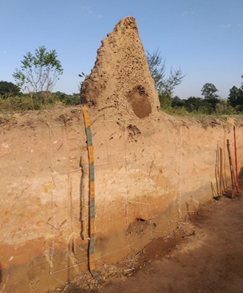Bioturbation: Unveiling the role of ants and termites in the phytolith assemblage of tropical soils – First IPS Envoy Post by Carolina Glaeser Benincá
- Post by: Admin
- April 9, 2024
- No Comment
Over two thousand years ago, the French naturalist Saint’ Hilaire said: “soit le Brésil finit avec la fourmi [saúva], soit la fourmi finit avec le Brésil” [Either Brazil ends the ants [leaf-cutter] or the ant ends Brazil], dramatically illustrating the profound impact that a single biological element can have on the balance and sustainability of an ecosystem.
Atta or leaf-cutter ants are considered the dominant herbivores of the Neotropics. Their abundance and high activity in tropical environments deeply affect the vegetation cover and soils as they develop colonies that can reach several tens of meters depth and remain active for decades, processing tons of leaves each year! Ants, along with termites and worms, are ecosystem engineers, whose dynamics influence the physical structure of the soil and the flow of nutrients and energy through digging, mounding, mixing and burial.
These animals’ colonies act as a superorganism derived from a high degree of eusociality (cooperation of individual organisms for the single benefit of the group). In their coordinate efforts to maintain an organized and secure nest, millions of workers move soil and organic matter inside and outside the soil profile, creating different sized mounds, pores, chambers, channels and microaggregates – (bio)turbating tons of mineral matter annually and leaving footprints that can be recognized at macro and micro scale.
Bioturbation is a fascinating phenomenon that dates back to Charles Darwin’s (1881) observations on the importance of earthworms in soil mixing and formation. Now we know it is a key pedogenetic factor performed by organisms with vital ecosystem functions in a delicate web of interactions.
The complexity of life and faunal activity in tropical soils is often a challenge for pedological and environmental studies. When performing phytolith sampling, extraction and analysis, bioturbation’ impacts aren’t always taken into consideration. Edaphic fauna potentially impacts not only the deposition and formation of soluble silica pools but also phytolith preservation, including morphological aspects, as well as their position within the soil profile, possibly compromising the accuracy of information and leading to misinterpretation of the soil phytolith assemblage. Because the soil is a complex living record, a careful and detailed analysis is imperative for phytolith researchers in tropical environments.
These complex problem raised the interest of researchers from Laboratório de Estudos da Dinâmica Ambiental (LEDA) from Universidade Estadual do Oeste do Paraná – Unioeste, campus Marechal Cândido Rondon, Paraná, south Brazil. The laboratory is currently developing a project that aims to increase understanding of phytolith dynamics in heavily bioturbated soils. The study is being conducted at two sites with different soils and main edaphic fauna – one has clay texture soil from Paraná state and a leaf-cutting ant colony, the second is in São Paulo estate with coarse-texture soil covered with a termite nest.
The analyses are being developed by a group of scientists, with one undergrad student funded by Brazil’s Concelho Nacional de Desenvolvimento Científico e Tecnológico (CNPq) and one master’s degree student funded by Fundação Coordenação de Aperfeiçoamento de Pessoa de Nível Superior (CAPES). The overall research project is funded by Fundação Araucária (grant number 341/2022) and is being developed in partnership with Laboratório de Química de Solos Tropicais and Laboratório de Micromorfologia of ESALQ/USP, plus Laboratório de Carbono 14 of Centro de Energia Nuclear na Agricultura (CENA/USP).
Phytolith pools in the soil, litter, and the insect colony’s channels and chambers are being investigated by identifying phytolith assemblages and the potential input and output of silica. This study utilizes established techniques in soil science and archaeobotany, such as soil micromorphology, 14C dating, 13C isotope evaluation, and weathering indexes to assess the impact of this kind of biological activity on phytolith assemblage composition and preservation in tropical soils, with emphasis on taphonomic processes.
The LEDA laboratory has long been engaged for years studying different Brazilian biomes, organizing an extensive phytolith reference collection with over 500 plant species and many different soils. Also, the laboratory has developed techniques for phytolith extraction in tropical soils – a project that began in 2013, developed with financial support from the Brazilian Federal Government (CAPES PVES Project A115/2013) a partnership between Brazilian universities Unioeste and Escola Superior em Agricultura “Luiz de Queiróz” (ESALQ/USP) and Pompeu Fàbra University from Barcelona – Spain. During this time, several Brazilian researchers have learned phytolith extraction and analysis procedures through LEDA’ courses and are developing new phytolith research projects across the country.
The collaborative effort between various institutions and professionals reflects a commitment to increase understanding of tropical soil dynamics using a multiproxy approach, opening the way for deeper understanding of the dynamics between soil life and paleoenvironmental records in tropical ecosystems.
Ants and termites are ecosystem engineers that actively contribute to phytolith incorporation and post-depositional dynamics in soil. Paraphrasing the naturalist, either Brazil unravels some of ant’s mystery or continues to be outwitted by them.

Leaf-cutter ant colony in soil profile from Marechal C. Rondon, western Paraná, Brazil
Photos from Sep. 2022 and Dec. 2022, respectively – notice the amount of mobilized soil and that previously exposed chambers and channels were sealed.



